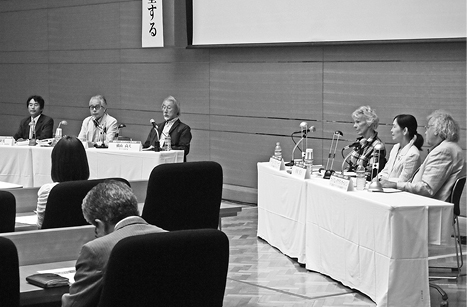Discussion
講評会
Questions and answers
(2/2)

Takeda ───── Professor Laursen, do you have any problems in Danish glass scene?
Laursen ───── Denmark is hit by the economic crises. It is worldwide. It seems to be obvious. That, in a way, has made some difficulties, I think, for especially designer craft schools in Denmark. They do not have the same support from the state as they used to have. And also this tendency that Mr Carlson talked about is that the education within glass, ceramics, textiles, whatever craft, has become more theoretical. So nowadays it seems that another effort is put into explaining what you are doing, into taking up interesting philosophical positions, in some ways to take away your attention from the material itself. It is a general tendency,I think, but still craft and craft education exist in Denmark.There are interesting new things going on, so I am not pressed, but it is not as affluent as maybe in the States. There are our possibilities and there is a very international outlook in the educational policies. So that respects absolutely good opportunities.
Takeda ─────After listening to Professor Carlson and Professor Laursen, does anyone have further questions?
Audience 2 ───── Are there international glass competitions like this in other countries at present? If so, please tell me which countries have what kind of activities in the world.
Carlson ───── I think that the competition like this is very unique. In the past, the last 30 to 40 years, there were other competitions that were international based in Europe and the US. Japan though has been a leader in establishing and maintaining these exhibitions from “The World Glass Now in Hokkaido” back in the 80’s to Kanazawa. Maybe some other ones but I do not remember. It is quite a leap for our institution or government or sponsor to put it together. And it is vitally necessary if we have that kind of international community of practice and familiarity to support these programs.But there are very few far in-between.
Laursen ───── Not worldwide like the Kanazawa exhibition and contest, but in Europe, actually in Denmark, we have every second year contest but it is only European. So I should suggest we could invite other countries as well. But this competition has been performed several times now and it works well. So let’s see what can be done as Mr Carlson said. This Kanazawa international competition is unique and so important.
Takeda ───── Thank you for giving the audience important information.As the jurors mentioned, quite a few works are sent from the countries we have never been to. It means a lot of people have been interested in glass and expressed themselves.That is to say, glass plays a significant role in uniting the glass artist in Japan as well as in other countries. That is all for today’s Round Table Discussion. Thank you.
Closing Remarks
Arakawa ───── We would like to bring this Round Table Discussion to a close. I would like to thank all the jurors for their lively discussions and stimulating opinions. Ladies and gentlemen, thank you for participating in today’s Round Table Discussion.
I would also like to mention that the International Exhibition of Glass Kanazawa 2013 will be held at the Shiinoki Cultural Complex, Ishikawa Prefecture and the Kanazawa 21st Century Museum of Contemporary Art, Kanazawa from October 23rd through November 4th 2013. The award winners as well as the 52 selected works will be displayed.In addition, the Design Center Ishikawa’s collection, prize winners and selected works in the previous exhibitions,will be introduced. The International Exhibition of Glass Kanazawa 2013 will visit the Notojima Glass Art Museum from November 30th 2013 through January 26th 2014. I hope many of you will visit these exhibitions.
We would like to close the Round Table Discussion for the International Exhibition of Glass Kanazawa 2013. Please give all the jurors another round of applause. Thank you very much.

